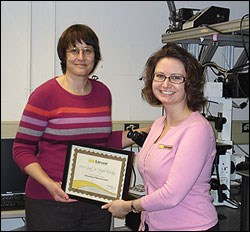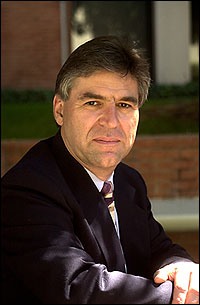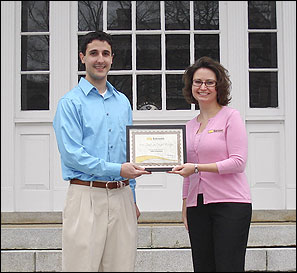
Edmund Optics Honors ‘Optics Superheroes’
BARRINGTON, N.J., Jan. 4, 2011 — Optical components maker Edmund Optics announced the winners of its 2010 Higher Education Grant program. Selected from more than 250 applicants, the first-, second-, and third-place finalists receive grants of $10,000, $7500, and $5000, respectively, in Edmund Optics products to support their research and educational activities. An additional 11 finalists will receive matching grants of $500 for purchase of Edmund Optics products.

First-place 2010 Grant Award Winner Dr. Lori Goldner (left), University of Massachusetts and Kirsten Bjork-Jones, director, global marketing, Edmund Optics.
"We are constantly surprised and impressed at the diversity and caliber of the optical techniques that our applicants are utilizing," said Marisa Edmund, vice president of Marketing and Communications for Edmund Optics. "Each of our award recipients and finalists are superheroes in their field and it is immensely gratifying to know how Edmund Optics' products and services are supporting their work. We are thrilled to support them even further with the award of our Higher Education Grants."
The 2010 Grant program made its initial selection of 14 finalists by evaluating applications for the innovation, technical impact, industry benefit and educational benefit of their projects. In-depth personal interviews resulted in the final selection of Lori Goldner, professor of Physics at the University of Massachusetts Amherst; Armand R. Tanguay, Jr., professor of Electrical Engineering, Materials Science, Biomedical Engineering, and Ophthalmology at the University of Southern California (USC); and Corey Shemelya, a graduate student in Electrical Engineering at Tufts University, as the top three "Optics Superheroes" for this year's grant.

Second-place 2010 Grand Award Winner, professor Armand R. Tanguay Jr., USC.
Third-place award recipient Shemelya is working on the development of optical tools for the evaluation of materials used in photovoltaic and thermophotovoltaic power generation. The tools will support his research into material selection and processing for the fabrication of these two different device structures. While concentrating photovoltaic cells should achieve conversion efficiencies of over 50 percent, which is a significant improvement, the thermophotovoltaic cells could be used to improve the energy efficiency of any device by harvesting waste heat.
Tanguay is developing an ultraminiature camera that can be implanted in the human eye and connected via a microelectrode array to the retina, with the ultimate goal of restoring sight to the blind. Previous retinal prostheses, already in clinical trials, used an external camera mounted on eyeglasses, requiring extensive head movements to scan the environment. By contrast, the intraocular camera's location within the sac that normally contains the eye's lens allows for a natural coupling of head and eye movements. The degree of camera miniaturization required is made possible by studies of the visual psychophysics of human vision in the low resolution limit, which in turn relaxes key imaging constraints. This project involves an interdisciplinary collaboration with retinal surgeon Dr. Mark S. Humayun at USC, and holds long-term promise for restoring functional vision to victims of degenerative diseases such as Retinitis Pigmentosa and Age-Related Macular Degeneration.

Third-place 2010 Grant Award Winner Corey Shemelya, Tufts University graduate student, with Bjork-Jones.
First-place recipient, Goldner, is developing state-of-the-art optical equipment that allows microscopic examination of single biomolecules and their interactions with their environment. Tightly focused laser beams serve as "optical tweezers" to position sub-micron-sized droplets of fluid that contain the molecule, acting as a tiny test tube. Goldner can then investigate the structure and actions of the molecule using a confocal fluorescence microscope. These techniques have application both in biochemistry, where they allow detailed examination of molecular interactions such as those between proteins and RNA, as well as in physics, where they can be used to observe how biomolecules assemble into complex structures such as crystals and tubes. Ultimately, the studies will aid in the development of more effective drugs and advanced nanofabricated materials.
In addition to conducting advanced research in optical techniques for biophysics, Goldner is a “superhero” mentor to her students. She has made her laboratory equipment available to her students so that they can gain first-hand experience with the tools and techniques they will need to use in their own work after graduation. Her intention for the grant award is to fabricate optical tweezers and other advanced optical tools that can be dedicated to student use "so I can get my own stuff back," she said.
For more information, visit: www.edmundoptics.com/grant
/Buyers_Guide/Edmund_Optics_Inc/c4064